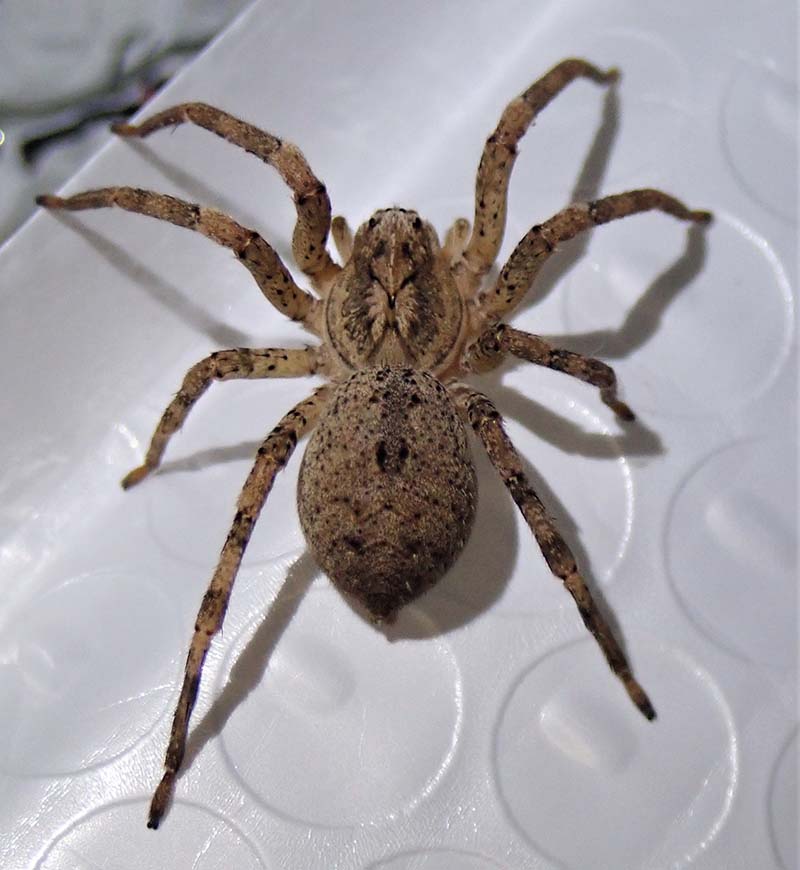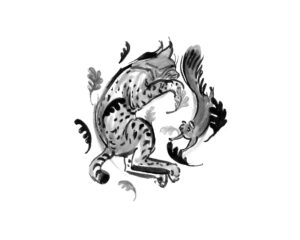
If, like me, you have come across a relatively large fuzzy mottled tan spider in your Bay Area home, chances are you were meeting Zoropsis spinimana, a spider species native to the Mediterranean that was unintentionally introduced to the Bay Area in the early 1990s.
I first met Zoropsis a couple years ago and although it was a brief introduction, I was left intrigued. My husband and I had just arrived home, later in the evening than our two dogs were accustomed to so they were particularly eager for their bedtime treat. I hurried across the dim kitchen and bent down to open the dog treat drawer. My husband flicked on the light and suddenly I could see, inches from my face, a large tan spider contrasting against the shiny silver of the dishwasher door. The startled spider froze as though I had just caught it sneaking a midnight snack, then it ran for cover between the dishwasher and cabinets. Wolf spider? I wondered. But it was a surprisingly light tan color and looked a bit different than the wolf spiders I was familiar with, and wolf spiders are not often found indoors. I recalled a handful of posts I had seen on an online neighborhood message board, each with photos of a big spider on a bedroom wall or kitchen countertop and variations of the alarmed question, what the heck is this!? I found the posts and scrolled through the comments until I came to one proposing they were a non-native species named Zoropsis spinimana. Now I had a lead!
Several weeks later, while shampooing my hair, I opened my eyes and started at the sight of a large spider silhouette high on the glass shower door. It appeared to be that same light tan individual I had met in the kitchen! Luckily it was on the outside of the glass and I calmly called for my husband, who only heard me after a few increasingly urgent attempts. He rushed in, stopped in his tracks, blurted an expletive and stood staring at the spider in amazement. “Get the container, please,” I said as patiently as I could. The container is a clear plastic jar paired with a thin square of cardboard that we keep easily accessible for humanely relocating spiders. To our surprise, the spider remained motionless until surrounded by the jar, then walked around slowly, searching for an exit.

I was arachnophobic for most of my life. During graduate school, while living in a converted garage studio featuring stressful daily encounters with various creepy crawlies, I discovered that when I took a little time to identify and learn about each species, the fear dissipated and I developed a sense of connection and appreciation. So, knowing me well, my husband left the captured spider on the dining room table so I could snap some photos of it for reference while identifying and researching the species after releasing the individual into the leafy yard.
Following my lead from the message board, I searched for articles and photos of Zoropsis spinimana and compared its characteristics and markings to those of my relocated houseguest. Bingo! My new friend was, in fact, the Mediterranean expat.
I soon learned that while populations of Zoropsis have become established within the greater Bay Area, the species is still not found elsewhere in the United States. It has, however, spread from the Mediterranean to other regions, including colder and wetter areas in Europe. I was curious to understand what might be spurring Zoropsis into less hospitable climates, so I contacted Darrell Ubick, an arachnologist at the California Academy of Sciences who was among the first to identify and track the species’ presence in California.
“There could be more than one factor involved in the spread of these spiders, but I would put increased human travel at the top of the list,” Ubick said. “A gravid female can be easily transported in luggage and can become established if it ends up in a favorable environment, like somebody’s warm house.”
Zoropsis can probably only survive cold climates with the shelter and food sources available indoors. However, climate change might be making regions outside its historical range warmer, which could influence its future homemaking plans.
After my first encounters with Zoropsis, months went by without a sign and I found myself hoping to get another close look. On a warm spring afternoon, while helping my husband clear some things out of our garage, I finally got my wish. My husband had just carried some sawhorses out onto the driveway and as he put them down, I saw it, crouched on the underside of the metal bar right next to where his hand had just been, its long legs drawn close around its body. I pointed at it excitedly and my husband’s eyes grew wide making me laugh. “Your hand probably touched it and it didn’t bite you!” I exclaimed. I gently picked up the sawhorse and carried it to a nearby shrub slowly coaxing the scared spider onto a branch. With its legs outstretched, I could see it was close to the nearly two inches in length, including legs. This individual was a darker tan color than my previous houseguest but had the characteristic multiple dark brown flares along the top surface of its abdomen and fuzzy looking spines and brown speckles and bands along its legs.
That interaction confirmed that Zoropsis, like many spiders, is generally shy, solitary, and not aggressive toward humans. Understandably, it might bite if threatened and its clasping mouthparts (chelicerae) are able to pierce human skin. Like most spiders, Zoropsis has venom glands used to subdue its prey, but there are no verified significant medical reactions caused by its bite and it is considered harmless to humans.
Zoropsis is a hunting spider so it does not build webs to catch prey or for shelter, and instead uses its silk to protect its eggs. The individuals I observed seemed relatively slow-moving though I learned they can move quickly when attacking prey, which consists of insects and other spiders. Perhaps this means that even if you are not a fan of spiders, leaving Zoropsis and other hunting spiders you find indoors might actually help reduce not only the number of insects in your home, but also its overall spider population.
I wondered if Zoropsis competed with native spiders for food or had other ecological impacts and put the question to Ubick. “I don’t know of any studies looking at the ecological impacts [in California], but my feeling is that they would be minimal,” he said. “Zoropsis seems to be restricted to human habitation, where most of the species are also introduced, and so would not negatively impact the native fauna.”
Comforted by this knowledge, my interest in Zoropsis continues, and I look forward to future meetings since, by cozying up in homes like mine, Zoropsis spinimana has become an established member of California’s diverse spider species.




